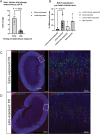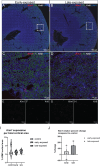Windows of susceptibility to neonatal acute kidney injury and nephron loss in a rabbit model
- PMID: 40596708
- PMCID: PMC12215908
- DOI: 10.1038/s41598-025-08685-w
Windows of susceptibility to neonatal acute kidney injury and nephron loss in a rabbit model
Abstract
Nephrogenesis is completed before term birth, but preterm infants continue this process postnatally. It is unknown if preterm neonates are more susceptible to acute kidney injury (AKI) immediately after birth (during nephrogenesis) or later in postnatal development, and if this AKI timing impacts nephron number. Rabbits were exposed to gentamicin (100 mg/kg intraperitoneal) and indomethacin (5 mg/kg orally) on postnatal day (P) 0-3 (early-exposed) or P6-9 (late-exposed). Animals were euthanized three hours after last nephrotoxin dose or at 6 weeks of life. Histologic injury was assessed, and Kidney injury marker 1 (Kim1) expression was quantified. At 6 weeks, blood urea nitrogen (BUN) and serum creatinine (SCr) levels were measured. Ex vivo MRI imaging was performed with automated quantitation of nephron numbers. AKI was induced in early and late-exposed rabbits. At 6 weeks, we identified a mean of 170,972 glomeruli in the controls (n = 5), 159,655 in the early-exposed (n = 4), and 145,748 glomeruli in the late-exposed group (n = 3, a 14.8% reduction compared to control, p = 0.01). Late-exposed rabbits had elevated BUN and SCr relative to early-exposed. This study suggests that exposure to nephrotoxins during early postnatal nephrogenesis causes AKI but may have less impact on long-term nephron number than exposure during nephron maturation.
Keywords: Chronic kidney disease; Neonatal acute kidney injury; Nephrogenesis; Nephrotoxins; Prematurity.
© 2025. The Author(s).
Conflict of interest statement
Declarations. Competing interests: The authors declare no competing interests.
Figures




Similar articles
-
Early erythropoietin for preventing red blood cell transfusion in preterm and/or low birth weight infants.Cochrane Database Syst Rev. 2006 Jul 19;(3):CD004863. doi: 10.1002/14651858.CD004863.pub2. Cochrane Database Syst Rev. 2006. Update in: Cochrane Database Syst Rev. 2012 Sep 12;(9):CD004863. doi: 10.1002/14651858.CD004863.pub3. PMID: 16856062 Updated.
-
Higher versus lower sodium intake for preterm infants.Cochrane Database Syst Rev. 2023 Oct 12;10(10):CD012642. doi: 10.1002/14651858.CD012642.pub2. Cochrane Database Syst Rev. 2023. PMID: 37824273 Free PMC article.
-
Paracetamol (acetaminophen) for patent ductus arteriosus in preterm or low birth weight infants.Cochrane Database Syst Rev. 2018 Apr 6;4(4):CD010061. doi: 10.1002/14651858.CD010061.pub3. Cochrane Database Syst Rev. 2018. Update in: Cochrane Database Syst Rev. 2020 Jan 27;1:CD010061. doi: 10.1002/14651858.CD010061.pub4. PMID: 29624206 Free PMC article. Updated.
-
Late (> 7 days) systemic postnatal corticosteroids for prevention of bronchopulmonary dysplasia in preterm infants.Cochrane Database Syst Rev. 2017 Oct 24;10(10):CD001145. doi: 10.1002/14651858.CD001145.pub4. Cochrane Database Syst Rev. 2017. Update in: Cochrane Database Syst Rev. 2021 Nov 11;11:CD001145. doi: 10.1002/14651858.CD001145.pub5. PMID: 29063594 Free PMC article. Updated.
-
Higher versus lower amino acid intake in parenteral nutrition for newborn infants.Cochrane Database Syst Rev. 2018 Mar 5;3(3):CD005949. doi: 10.1002/14651858.CD005949.pub2. Cochrane Database Syst Rev. 2018. PMID: 29505664 Free PMC article.
References
-
- Rodríguez, M. M. et al. Histomorphometric analysis of postnatal glomerulogenesis in extremely preterm infants. Pediatr. Dev. Pathol.7, 17–25. 10.1007/s10024-003-3029-2 (2004). - PubMed
MeSH terms
Substances
Grants and funding
LinkOut - more resources
Full Text Sources
Research Materials

